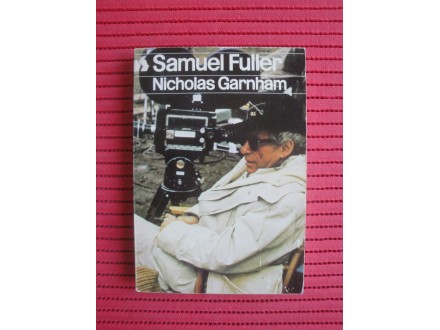Samuel Fuller by NICHOLAS GARNHAM
| Cena: |
| Želi ovaj predmet: | 3 |
| Stanje: | Polovan bez oštećenja |
| Garancija: | Ne |
| Isporuka: | Pošta Post Express Lično preuzimanje |
| Plaćanje: | Tekući račun (pre slanja)
Pouzećem Lično |
| Grad: |
Beograd-Čukarica, Beograd-Čukarica |
Godina izdanja: Ostalo
ISBN: Ostalo
Jezik: Engleski
Oblast: Film
Autor: Strani
Samuel Fuller by NICHOLAS GARNHAM
Published by Viking press (1972) na 176. strana, bogato ilustrovano.
Knjiga je odlicno ocuvana.
The Baron of Arizona (1950) was a fact-based tale about a greedy landowner (Vincent Price) who nearly corrals the entire Arizona Territory. The Steel Helmet (1951) was the first of Fuller’s war movies, a blistering account of the Korean War. It was the first American movie about that war and the first to mention the internment of Japanese Americans that had occurred during World War II. The movie generated controversy with its frank discussions of racism and its depiction of an American soldier shooting an unarmed prisoner of war. Fuller faced accusations that he had produced anti-American propaganda, but he maintained that war was, for the soldier, often simply something to survive.
The Steel Helmet, shot in only 10 days, brought Fuller to the attention of the major studios, and he was signed by Twentieth Century-Fox, where he would make seven of his next eight pictures. First came another Korean War picture, Fixed Bayonets! (1951). Fuller then directed Park Row (1952), a tribute to journalism set among dueling newspapers in 1886 New York City. Pickup on South Street (1953) was a noir with a Cold War theme. Richard Widmark played a penny-ante pickpocket who unknowingly lifts a roll of microfilm that both the Russians and the FBI want, ultimately landing him on the side of the law. Thelma Ritter was Oscar nominated for her colourful role as a hard-luck snitch. Hell and High Water (1954) was a more conventional submarine adventure also starring Widmark.
House of Bamboo (1955) was a crime story set in Japan, with Robert Stack as an army investigator who goes undercover to hunt a gang of rogue American ex-soldiers (led by Robert Ryan) who are robbing army ammunition trains. Run of the Arrow (1957) exhibited the distinctive Fuller touch of black humour mixed with a deep streak of cynicism. A bitter Confederate soldier (Rod Steiger) joins a Sioux tribe after the American Civil War. Forty Guns (1957) was a western, with Barbara Stanwyck as the haughty head of Tombstone until being tamed by lawman Barry Sullivan. China Gate (1957) was an anticommunist action film that featured Gene Barry and Nat King Cole as mercenaries working for the French to blow up a munitions stockpile in Vietnam.
With Shock Corridor (1963) and The Naked Kiss (1964), both made for Allied Artists, Fuller had almost total freedom, resulting in two of his most accomplished—and disturbing—works. Shock Corridor starred Peter Breck as a reporter who has himself committed to an institution in order to track down a murder suspect but ultimately loses his sanity. The three mental patients who witnessed the murder serve as a symbolic critique of America: an African American college student who acts like a white racist, a nuclear weapons scientist who has regressed to childhood, and a veteran, broken by torture during captivity in Korea, who believes he is the Confederate general Jeb Stuart.
The Naked Kiss was even more shocking, centred on a former prostitute (Constance Towers) who tries to attain respectability by moving to a quiet town but learns that her new boyfriend (Anthony Eisley) is a child molester. The opening scene, shot mostly in handheld point-of-view shots, has often been cited as a perfect example of Fuller’s explosive style: Towers beats up her pimp, who in turn tears off her wig to reveal her bald head. The Naked Kiss’s unblinking confrontation of utter loathsomeness shocked audiences of the day. Unsurprisingly, it was not commercially successful.
Fuller had come to be appreciated by younger directors. He appeared as himself in a cameo in Jean-Luc Godard’s Pierrot le Fou (1965). In that movie, when asked by Jean-Paul Belmondo to define cinema, Fuller’s reply—which came to epitomize his movies—was: “A film is like a battleground. It’s love. Hate. Action. Violence. Death. In one word: emotions.”
In 1969 he directed Burt Reynolds in Shark! (also called Caine), a treasure-hunt picture made as a coproduction with a Mexican company. Tote Taube in der Beethovenstrasse (1973; Dead Pigeon on Beethoven Street) was shot for West German television as an episode of the crime series Tatort. Glenn Corbett starred as a private eye in the Raymond Chandler vein who is hired by a woman played by Christa Lang. (Lang was Fuller’s real-life wife; Fuller himself played a U.S. senator.)
Ne saljem van Srbije.
Zbog visoke cene provizije post expresa predlazem da prethodno uplatite novac na ziro racun, dok cu vam knjigu poslati post expresom kome cete platiti samo postarinu.
Postoji mogucnost smanjenja postarine, ali samo ako znate broj vase dostavne poste, U tom slucaju knjigu preuzimate direktno u posti, pa je zato jeftinije.
Predmet: 77421465













